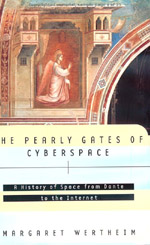 (Reprinted with permission from The Financial Times, written by Lilian Pizzichini.)
(Reprinted with permission from The Financial Times, written by Lilian Pizzichini.)
According to Margaret Wertheim, “the Heavenly City of New Jerusalem was the great promise of early Christianity” that set it apart from other obscure religious sects of the time. Wertheim, an Australian science journalist, states in The Pearly Gates of Cyberspace that Christianity’s initial appeal must be set in the context of the disintegration of Imperial Rome. The offer of “an eternal heaven of radiance and light” achievable by disciples of the new religion was all the more attractive given the disharmony and chaos reigning on earth.
By the Middle Ages, a dualistic cosmology in which the physical world was enclosed by a spiritual, immaterial space was firmly established. And it was only in this latter space that the soul could operate.
Then comes Wertheim’s neat segue to our own era—that of Pax Americana and the end of empires—in which, instead of Jesus’s final, democratic resting place of bliss, we have the internet. For dedicated net-heads, living in an age devoid of spiritual space, “today’s cybertheologians” offer a virtual transcendence via bits and bytes that are electronically configured in a non-physical space. As such, cyberspace offers a genuine if immaterial world in which people are invited to commune in a non-bodily fashion, just as medieval Christians rose up to “the heavens” after life on earth.
Essentially, Wertheim treats the net as though it were a liberating force that has broken free from the iron rule of physics. What is most interesting about her thesis is that through her reading of literary and philosophical texts, cyberspace can be seen as the latest expression of the human desire for a spiritual life that takes place within a codified site.
It is no coincidence that cyberspace has attracted a host of new religious sects, and she firmly puts them in their place. But first she has to explain how we lost sight of the heavens above, and how Dante, the “supreme cartographer of Christian soul-space,” was superseded by Einstein.
For the purpose of her book, The Divine Comedy must be seen as a “journey out of Hell and up the stairway of purgation to Heaven.” What interests her most is the spatial arrangement of the ascent. Dante’s “soul-space” is organized into hierarchies, with sin acting as the gravitational force that pulls the soul down towards Hell. As the “virtual Dante” travels through Purgatory, sin is lifted from him until he is light enough to reach Heaven’s pearly gates. As Wertheim triumphantly concludes, “The very structure of the space encodes the spiritual transformation being enacted.”
It was perspective as employed by Giotto that changed the shape of that space. As a pioneer in the “technology of visual representation” his geometric figuring created the illusion of three-dimensional reality. In his work, St. Francis is shown moving through “real” space and is drawn on the same scale as a beggar. To make the illusion more real, Giotto painted shadows into his frescoes that seem to be cast by the actual windows on a church’s walls. This interplay of architecture and art and the astonishing realism of his images diffused the boundaries between celestial and terrestrial spaces.
Next in Wertheim’s packed account is Galileo with his telescope locating a sun-centered cosmos with no physical boundaries. This is the age, as Henri Lefebvre said, when mathematicians appropriated space. Newton’s law of gravity asserted that a single physical force operated in both celestial and terrestrial realms.
Much later, and even more radically from a theologian’s point of view, Hubble got out his telescope and realized that space had a history. “From stasis to story,” the Big Bang destroyed the notion of an eternal, celestial realm, and Wertheim’s conclusion, years down the line, is that once the physical world is perceived as infinite, there is literally no space for the spirit.
Which brings her back to Dante, and The Divine Comedy as a prototype MUD (Multi-User Domain). MUDs are computer-generated spaces, or virtual combat zones, in which subscribers assume alternative identities. Just as Dante must journey through circles and spheres of spiritual progression, the disembodied player must advance through varying levels of expertise. Her equation of the “wizard” who creates the MUD with “Dante’s heavenly elect” is dubious—after all, Dante’s is a moral journey that ends with perfection.
Luckily, though, Wertheim is not simple-minded enough to pursue the analogy. She recognizes that when we download our minds on to our PCs, we may be entering a realm in which “souls” are freed from “the bloody mess of organic matter,” but there is no underlying moral code or sense of communal responsibility. We have re-created a space for out-of-body experiences, and the possibility therein of an eternal resting-place for our cybersouls. But she leaves the question—Is this space heaven or hell?—to future cyberhistorians.